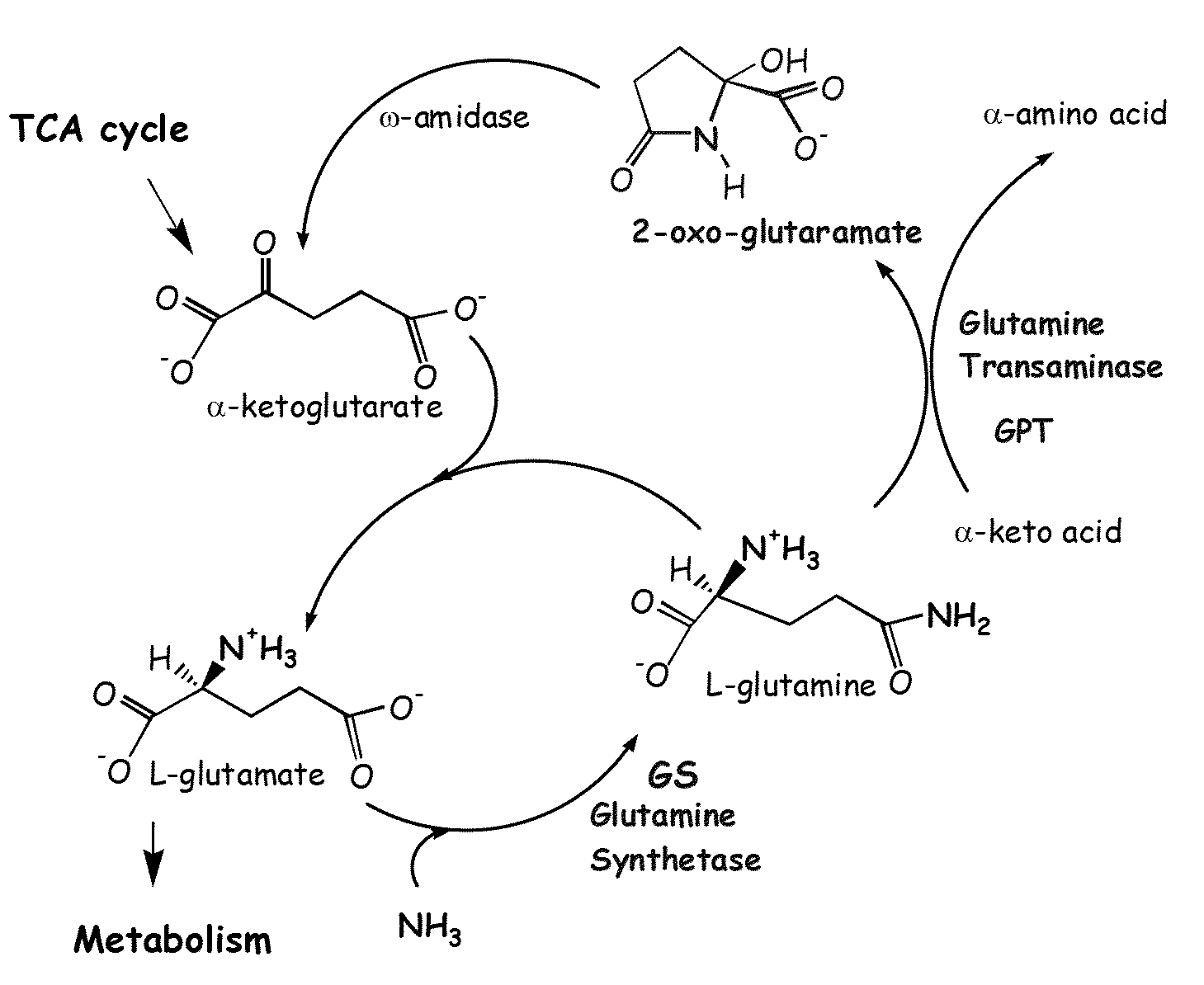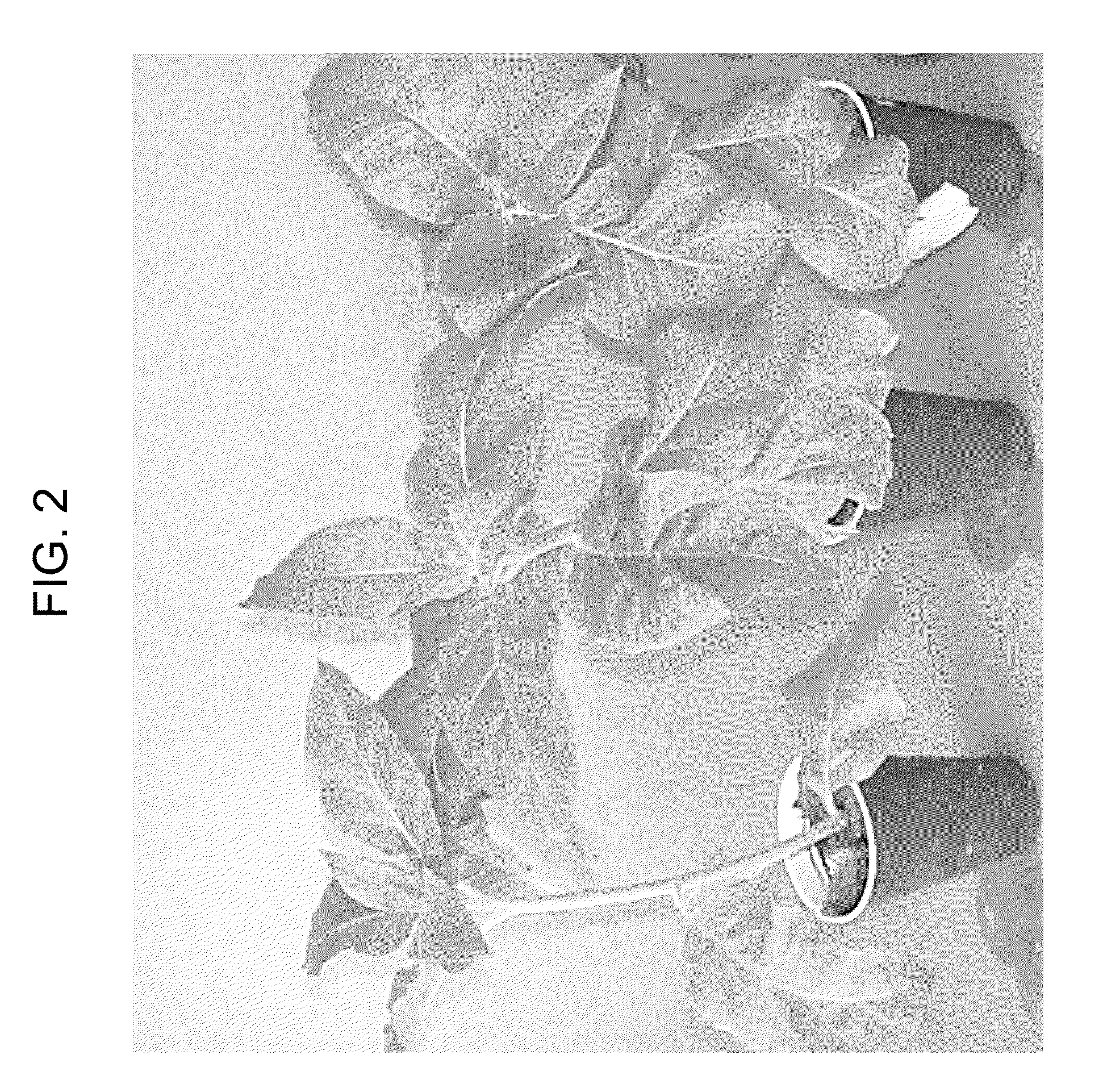Plant Glutamine Phenylpyruvate Transaminase Gene and Transgenic Plants Carrying Same
a technology of glutamine phenylpyruvate and transaminase gene, which is applied in the field of plant glutamine phenylpyruvate transaminase gene and transgenic plants carrying same, can solve the problems of slow adoption of genetically modified plants in agriculture in many regions of the world, and the regulatory mechanisms of plant carbon and nitrogen metabolism are not fully elucidated, so as to improve the growth rate, increase the biomass yield, and enhance the growth characteristics
- Summary
- Abstract
- Description
- Claims
- Application Information
AI Technical Summary
Benefits of technology
Problems solved by technology
Method used
Image
Examples
example 1
Isolation of Arabidopsis Glutamine Phenylpyruvate Transaminase (GPT) Gene
[0107]In an attempt to locate a plant enzyme that is directly involved in the synthesis of the signal metabolite 2-oxoglutaramate, applicants hypothesized that the putative plant enzyme might bear some degree of structural relationship to a human protein that had been characterized as being involved in the synthesis of 2-oxoglutaramate. The human protein, glutamine transaminase K (E.C. 2.6.1.64) (also referred in the literature as cysteine conjugate 1-lyase, kyneurenine aminotransferase, glutamine phenylpyruvate transaminase, and other names), had been shown to be involved in processing of cysteine conjugates of halogenated xenobiotics (Perry et al., 1995, FEBS Letters 360:277-280). Rather than having an activity involved in nitrogen assimilation, however, human cysteine conjugate β-lyase has a detoxifying activity in humans, and in animals (Cooper and Meister, 1977, supra). Nevertheless, the potential involvem...
example 2
Production of Biologically Active Arabidopsis Glutamine Phenylpyruvate Transaminase
[0112]To test whether the protein encoded by the cDNA isolated as described in Example 1, supra, is capable of catalyzing the synthesis of 2-oxoglutaramate, the cDNA was expressed in E. coli, purified, and assayed for its ability to synthesize 2-oxoglutaramate using a standard method.
NMR Assay for 2-Oxoglutaramate
[0113]Briefly, the resulting purified protein was added to a reaction mixture containing 150 mM Tris-HCl, pH 8.5, 1 mM beta mercaptoethanol, 200 mM glutamine, 100 mM glyoxylate and 200 μM pyridoxal 5′-phosphate. The reaction mixture without added test protein was used as a control. Test and control reaction mixtures were incubated at 37° C. for 20 hours, and then clarified by centrifugation to remove precipitated material. Supernatants were tested for the presence and amount of 2-oxoglutaramate using 13C NMR with authentic chemically synthesized 2-oxoglutaramate as a reference. The products o...
example 3
Creation of Transgenic Tobacco Plants Over-Expressing Arabidopsis GPT
[0117]Generation of Plant Expression Vector pMON-PJU:
[0118]Briefly, the plant expression vector pMon316-PJU was constructed as follows. The isolated cDNA encoding Arabidopsis GPT (Example 1) was cloned into the ClaI-KpnI polylinker site of the pMON316 vector, which places the GPT gene under the control of the constitutive cauliflower mosaic virus (CaMV) 35S promoter and the nopaline synthase (NOS) transcriptional terminator. A kanamycin resistance gene was included to provide a selectable marker.
Agrobacterium-Mediated Plant Transformations:
[0119]pMON-PJU and a control vector pMon316 (without inserted DNA) were transferred to Agrobacterium tumefaciens strain pTiTT37ASE using a standard electroporation method (McCormac et al., 1998, Molecular Biotechnology 9:155-159), followed by plating on LB plates containing the antibiotics spectinomycin (100 micro gm / ml) and kanamycin (50 micro gm / ml). Antibiotic resistant coloni...
PUM
| Property | Measurement | Unit |
|---|---|---|
| Tm | aaaaa | aaaaa |
| Tm | aaaaa | aaaaa |
| temperature | aaaaa | aaaaa |
Abstract
Description
Claims
Application Information
 Login to View More
Login to View More - R&D
- Intellectual Property
- Life Sciences
- Materials
- Tech Scout
- Unparalleled Data Quality
- Higher Quality Content
- 60% Fewer Hallucinations
Browse by: Latest US Patents, China's latest patents, Technical Efficacy Thesaurus, Application Domain, Technology Topic, Popular Technical Reports.
© 2025 PatSnap. All rights reserved.Legal|Privacy policy|Modern Slavery Act Transparency Statement|Sitemap|About US| Contact US: help@patsnap.com



